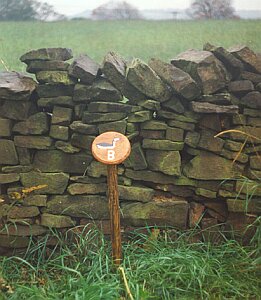
Opposite the school is a dry stone wall – these walls are a striking feature of the Derbyshire country landscape. They are built with two faces and have ‘fillers’ in the middle. ‘Through stones’ give extra strength and ‘capstones’ or ‘coping stones’ are placed on top. Traditionally cement is not used, although in recent years, it can be seen that some degree of cemet has been used mainly to hold coping stones in place, perhaps to deter thieves.
Some stone walls are 200 years old. They were built when the Enclosure Act of the 18th century caused huge open fields to be divided into the size of the field with which we are more familiar today. This occurred as farms showed ownership by consolidating their strips into one parcel of land and enclosed it with a boundary. The simplest way to build this boundary was too use the stones lying in the field, in Derbyshire it is mainly gritstone formed by rivers flowing over limestone and covering it with layers of sand.
When a wall was constructed, if a stone was picked up a place was found for it in the wall, no stone was ever put down. Sometimes a talisman was put at the base to thank the Earth Gods for allowing a wall to be built in that place. Look out for different dry stone wall designs along the trail.

Dry stone walls appear stark and lifeless but they provide valuable habitat for plants, animals and insects in exposed areas. Many varieties of flowering plants, ferns, lichens and mosses find the ideal home. The sunny face of the wall is desert like but the shaded side favours moisture loving plants. Insects and small animals live in and around walls – basking on the sunny side – living and breeding within the wall itself.
Remember – don’t climb over them and only adults might gently lift a top stone and then replace it exactly!
Further information about dry stone walls can be obtained from the Dry Stone Walling Association
An ideal place to learn more about stone and stone products is The National Stone Centre near Wirksworth, Derbyshire. The exhibition and trails at the National Stone Centre relate to many important elements of the National Curriculum and other school work. In May 2000, members of the Dry Stone Walling Association from all over Britain constructed a Millennium Wall, showcasing the different walling skills and traditions across the country. Children (and adults!) also have the opportunity to pan for gems in pools outside the exhibition centre. Located adjacent to the High Peak Trail, between Black Rocks and Middleton top, it makes an ideal stopping place for weary walkers and cyclists.



